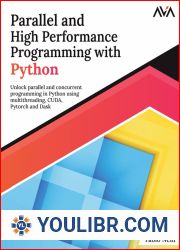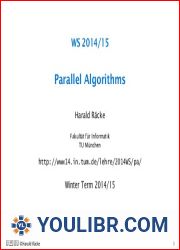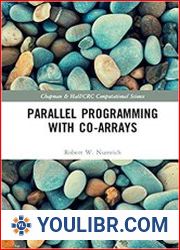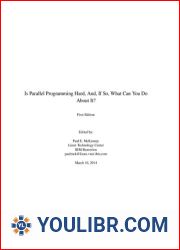
BOOKS - PROGRAMMING - Parallel Cryptanalysis

Parallel Cryptanalysis
Author: Ruben Niederhagen
Year: 2012
Format: PDF
File size: 0,8 MB.
Language: ENG
Year: 2012
Format: PDF
File size: 0,8 MB.
Language: ENG
Most of today’s cryptographic primitives are based on computations that are hard to perform for a potential attacker but easy to perform for somebody who is in possession of some secret information, the key, that opens a back door in these hard computations and allows them to be solved in a small amount of time. Each cryptographic primitive should be designed such that the cost of an attack grows exponentially with the problem size, while the computations using the secret key only grow polynomially. To estimate the strength of a cryptographic primitive it is important to know how hard it is to perform the computation without knowledge of the secret back door and to get an understanding of how much money or time the attacker has to spend. Usually a cryptographic primitive allows the cryptographer to choose parameters that make an attack harder at the cost of making the computations using the secret key harder as well. Therefore designing a cryptographic primitive imposes the dilemma of choosing the parameters strong enough to resist an attack up to a certain cost while choosing them small enough to allow usage of the primitive in the real world, e.g. on small computing devices like smart phones.
להוריד קובץ PDF descargar archivo pdf تنزيل ملف pdf pobierz plik pdf PDF-Datei herunterladen download pdf file download pdf file télécharger le fichier pdf скачать файл PDF Scarica il file pdf pdf dosyasını indir 下载 pdf 文件 PDFファイルをダウンロード descarregar ficheiro pdf pdf 파일 다운로드
La plupart des primitives cryptographiques modernes sont basées sur des calculs difficiles à exécuter par un attaquant potentiel, mais faciles à exécuter par celui qui possède certaines informations secrètes, une clé qui ouvre la porte dans ces calculs complexes et permet de les résoudre en peu de temps. Chaque primitive cryptographique doit être conçue pour que le coût de l'attaque augmente exponentiellement avec la taille de la tâche, tandis que les calculs à l'aide d'une clé secrète ne croissent que polynomialement. Pour évaluer la puissance de la primitive cryptographique, il est important de savoir à quel point il est difficile d'effectuer un calcul sans connaître le « mouvement noir » secret et d'avoir une idée de l'argent ou du temps que l'intrus doit dépenser. En général, la primitive cryptographique permet au cryptographe de choisir les paramètres qui rendent l'attaque difficile au prix d'une complexité des calculs à l'aide d'une clé secrète. Le développement de la primitive cryptographique pose donc le dilemme de choisir des paramètres suffisamment puissants pour résister à une attaque à un certain coût, tout en les choisissant suffisamment petits pour permettre l'utilisation de la primitive dans le monde réel, par exemple sur de petits appareils informatiques tels que les smartphones.
A maioria dos primitivos criptográficos modernos são baseados em cálculos difíceis de serem executados por um potencial intruso, mas é fácil de ser executado por alguém que possui alguma informação secreta, uma chave que abre a porta de trás nestes cálculos complexos e permite resolvê-los em pouco tempo. Todos os primórdios criptográficos devem ser projetados para que o custo do ataque cresça exponencialmente com o tamanho da tarefa, enquanto os cálculos com chave secreta crescem apenas polinomialmente. Para avaliar o poder de um primitivo criptográfico, é importante saber o quão difícil é fazer um cálculo sem saber a «saída» secreta e ter uma ideia de quanto dinheiro ou tempo um intruso deve gastar. Normalmente, os primórdios criptográficos permitem ao criptógrafo escolher os parâmetros que dificultam o ataque com a complexidade da computação usando a chave secreta. Por isso, o desenvolvimento de um primitivo criptográfico coloca o dilema de escolher parâmetros fortes o suficiente para resistir ao ataque a um determinado custo, ao mesmo tempo que escolhe-os pequenos o suficiente para permitir o uso de primitivos no mundo real, por exemplo, em pequenos dispositivos computacionais como smartphones.
Most of today’s cryptographic primitives are based on computations that are hard to perform for a potential attacker but easy to perform for somebody who is in possession of some secret information, the key, that opens a back door in these hard computations and allows them to be solved in a small amount of time. Each cryptographic primitive should be designed such that the cost of an attack grows exponentially with the problem size, while the computations using the secret key only grow polynomially. To estimate the strength of a cryptographic primitive it is important to know how hard it is to perform the computation without knowledge of the secret back door and to get an understanding of how much money or time the attacker has to spend. Usually a cryptographic primitive allows the cryptographer to choose parameters that make an attack harder at the cost of making the computations using the secret key harder as well. Therefore designing a cryptographic primitive imposes the dilemma of choosing the parameters strong enough to resist an attack up to a certain cost while choosing them small enough to allow usage of the primitive in the real world, e.g. on small computing devices like smart phones.
La maggior parte dei primitivi crittografici moderni sono basati su calcoli difficili da eseguire per un potenziale intruso, ma è facile eseguire per chi possiede alcune informazioni segrete, una chiave che apre la porta posteriore in questi calcoli complessi e permette di risolverle in poco tempo. Ogni primitivo crittografico deve essere progettato in modo che il costo dell'attacco cresca esponenzialmente con la dimensione dell'attività, mentre il calcolo con chiave segreta cresce solo in modo polinomiale. Per valutare il potere di un primitivo crittografico, è importante sapere quanto sia difficile eseguire un calcolo senza conoscere la porta sul retro segreta e avere un'idea di quanto denaro o tempo un intruso debba spendere. In genere, i primati crittografici consentono al crittografo di selezionare i parametri che rendono difficile l'attacco attraverso la complessità dei calcoli utilizzando una chiave segreta. Pertanto, lo sviluppo di un primitivo crittografico pone il dilemma della scelta di parametri abbastanza forti da resistere all'attacco fino a un certo valore, scegliendo di essere sufficientemente piccoli da permettere l'uso di primitivi nel mondo reale, ad esempio su piccoli dispositivi di elaborazione come gli smartphone.
Die meisten modernen kryptographischen Primitiven basieren auf Berechnungen, die für einen potenziellen Angreifer schwierig durchzuführen sind, aber für jemanden, der einige geheime Informationen besitzt, einfach durchzuführen sind, ein Schlüssel, der eine Hintertür in diesen komplexen Berechnungen öffnet und es ermöglicht, sie in kurzer Zeit zu lösen. Jedes kryptographische Primitiv muss so konzipiert sein, dass die Kosten eines Angriffs exponentiell mit der Größe der Aufgabe wachsen, während Berechnungen mit einem geheimen Schlüssel nur polynomisch wachsen. Um die Stärke eines kryptografischen Primitivs zu beurteilen, ist es wichtig zu wissen, wie schwierig es ist, eine Berechnung ohne Kenntnis der geheimen „Hintertür“ durchzuführen und eine Vorstellung davon zu bekommen, wie viel Geld oder Zeit ein Angreifer ausgeben muss. Typischerweise ermöglicht ein kryptographisches Primitiv einem Kryptographen, Parameter auszuwählen, die einen Angriff um den Preis komplizierter Berechnungen mit einem geheimen Schlüssel erschweren. Die Entwicklung eines kryptographischen Primitivs stellt daher das Dilemma dar, Parameter auszuwählen, die stark genug sind, um einem Angriff bis zu einem bestimmten Wert standzuhalten, während sie klein genug gewählt werden, um die Verwendung des Primitivs in der realen Welt zu ermöglichen, beispielsweise auf kleinen Computergeräten wie Smartphones.
La mayoría de las primitivas criptográficas modernas se basan en cálculos difíciles de realizar para un potencial atacante, pero fáciles de ejecutar para alguien que posee alguna información clasificada, una clave que abre la puerta de atrás en estos complejos cálculos y permite resolverlos en una pequeña cantidad de tiempo. Cada primitivo criptográfico debe ser diseñado para que el costo del ataque crezca exponencialmente con el tamaño del problema, mientras que los cálculos usando una clave secreta solo crecieron polinómicamente. Para evaluar el poder de una primitiva criptográfica, es importante saber lo difícil que es realizar un cálculo sin conocer la «marcha negra» secreta y hacerse una idea de cuánto dinero o tiempo debe gastar el atacante. Normalmente, la primitiva criptográfica permite al criptógrafo elegir parámetros que dificultan el ataque a costa de complicar los cálculos utilizando una clave secreta. Por lo tanto, el desarrollo de una primitiva criptográfica plantea el dilema de elegir parámetros lo suficientemente fuertes como para resistir un ataque a un valor determinado, al tiempo que los elige lo suficientemente pequeños como para permitir el uso de la primitiva en el mundo real, por ejemplo, en pequeños dispositivos informáticos como teléfonos inteligentes.
Большинство современных криптографических примитивов основаны на вычислениях, которые трудно выполнить потенциальному злоумышленнику, но легко выполнить тому, кто владеет некоторой секретной информацией, ключом, который открывает черный ход в этих сложных вычислениях и позволяет их решить за небольшое количество времени. Каждый криптографический примитив должен быть спроектирован таким образом, чтобы стоимость атаки росла экспоненциально с размером задачи, в то время как вычисления с использованием секретного ключа росли только полиномиально. Чтобы оценить силу криптографического примитива, важно знать, насколько трудно выполнить вычисление без знания секретного «черного хода» и получить представление о том, сколько денег или времени должен потратить злоумышленник. Обычно криптографический примитив позволяет криптографу выбирать параметры, которые затрудняют атаку ценой усложнения вычислений с использованием секретного ключа. Поэтому разработка криптографического примитива ставит дилемму выбора параметров, достаточно сильных, чтобы противостоять атаке до определенной стоимости, при этом выбирая их достаточно малыми, чтобы позволить использовать примитив в реальном мире, например, на небольших вычислительных устройствах, таких как смартфоны.
La plupart des primitives cryptographiques modernes sont basées sur des calculs difficiles à exécuter par un attaquant potentiel, mais faciles à exécuter par celui qui possède certaines informations secrètes, une clé qui ouvre la porte dans ces calculs complexes et permet de les résoudre en peu de temps. Chaque primitive cryptographique doit être conçue pour que le coût de l'attaque augmente exponentiellement avec la taille de la tâche, tandis que les calculs à l'aide d'une clé secrète ne croissent que polynomialement. Pour évaluer la puissance de la primitive cryptographique, il est important de savoir à quel point il est difficile d'effectuer un calcul sans connaître le « mouvement noir » secret et d'avoir une idée de l'argent ou du temps que l'intrus doit dépenser. En général, la primitive cryptographique permet au cryptographe de choisir les paramètres qui rendent l'attaque difficile au prix d'une complexité des calculs à l'aide d'une clé secrète. Le développement de la primitive cryptographique pose donc le dilemme de choisir des paramètres suffisamment puissants pour résister à une attaque à un certain coût, tout en les choisissant suffisamment petits pour permettre l'utilisation de la primitive dans le monde réel, par exemple sur de petits appareils informatiques tels que les smartphones.
A maioria dos primitivos criptográficos modernos são baseados em cálculos difíceis de serem executados por um potencial intruso, mas é fácil de ser executado por alguém que possui alguma informação secreta, uma chave que abre a porta de trás nestes cálculos complexos e permite resolvê-los em pouco tempo. Todos os primórdios criptográficos devem ser projetados para que o custo do ataque cresça exponencialmente com o tamanho da tarefa, enquanto os cálculos com chave secreta crescem apenas polinomialmente. Para avaliar o poder de um primitivo criptográfico, é importante saber o quão difícil é fazer um cálculo sem saber a «saída» secreta e ter uma ideia de quanto dinheiro ou tempo um intruso deve gastar. Normalmente, os primórdios criptográficos permitem ao criptógrafo escolher os parâmetros que dificultam o ataque com a complexidade da computação usando a chave secreta. Por isso, o desenvolvimento de um primitivo criptográfico coloca o dilema de escolher parâmetros fortes o suficiente para resistir ao ataque a um determinado custo, ao mesmo tempo que escolhe-os pequenos o suficiente para permitir o uso de primitivos no mundo real, por exemplo, em pequenos dispositivos computacionais como smartphones.
Most of today’s cryptographic primitives are based on computations that are hard to perform for a potential attacker but easy to perform for somebody who is in possession of some secret information, the key, that opens a back door in these hard computations and allows them to be solved in a small amount of time. Each cryptographic primitive should be designed such that the cost of an attack grows exponentially with the problem size, while the computations using the secret key only grow polynomially. To estimate the strength of a cryptographic primitive it is important to know how hard it is to perform the computation without knowledge of the secret back door and to get an understanding of how much money or time the attacker has to spend. Usually a cryptographic primitive allows the cryptographer to choose parameters that make an attack harder at the cost of making the computations using the secret key harder as well. Therefore designing a cryptographic primitive imposes the dilemma of choosing the parameters strong enough to resist an attack up to a certain cost while choosing them small enough to allow usage of the primitive in the real world, e.g. on small computing devices like smart phones.
La maggior parte dei primitivi crittografici moderni sono basati su calcoli difficili da eseguire per un potenziale intruso, ma è facile eseguire per chi possiede alcune informazioni segrete, una chiave che apre la porta posteriore in questi calcoli complessi e permette di risolverle in poco tempo. Ogni primitivo crittografico deve essere progettato in modo che il costo dell'attacco cresca esponenzialmente con la dimensione dell'attività, mentre il calcolo con chiave segreta cresce solo in modo polinomiale. Per valutare il potere di un primitivo crittografico, è importante sapere quanto sia difficile eseguire un calcolo senza conoscere la porta sul retro segreta e avere un'idea di quanto denaro o tempo un intruso debba spendere. In genere, i primati crittografici consentono al crittografo di selezionare i parametri che rendono difficile l'attacco attraverso la complessità dei calcoli utilizzando una chiave segreta. Pertanto, lo sviluppo di un primitivo crittografico pone il dilemma della scelta di parametri abbastanza forti da resistere all'attacco fino a un certo valore, scegliendo di essere sufficientemente piccoli da permettere l'uso di primitivi nel mondo reale, ad esempio su piccoli dispositivi di elaborazione come gli smartphone.
Die meisten modernen kryptographischen Primitiven basieren auf Berechnungen, die für einen potenziellen Angreifer schwierig durchzuführen sind, aber für jemanden, der einige geheime Informationen besitzt, einfach durchzuführen sind, ein Schlüssel, der eine Hintertür in diesen komplexen Berechnungen öffnet und es ermöglicht, sie in kurzer Zeit zu lösen. Jedes kryptographische Primitiv muss so konzipiert sein, dass die Kosten eines Angriffs exponentiell mit der Größe der Aufgabe wachsen, während Berechnungen mit einem geheimen Schlüssel nur polynomisch wachsen. Um die Stärke eines kryptografischen Primitivs zu beurteilen, ist es wichtig zu wissen, wie schwierig es ist, eine Berechnung ohne Kenntnis der geheimen „Hintertür“ durchzuführen und eine Vorstellung davon zu bekommen, wie viel Geld oder Zeit ein Angreifer ausgeben muss. Typischerweise ermöglicht ein kryptographisches Primitiv einem Kryptographen, Parameter auszuwählen, die einen Angriff um den Preis komplizierter Berechnungen mit einem geheimen Schlüssel erschweren. Die Entwicklung eines kryptographischen Primitivs stellt daher das Dilemma dar, Parameter auszuwählen, die stark genug sind, um einem Angriff bis zu einem bestimmten Wert standzuhalten, während sie klein genug gewählt werden, um die Verwendung des Primitivs in der realen Welt zu ermöglichen, beispielsweise auf kleinen Computergeräten wie Smartphones.
La mayoría de las primitivas criptográficas modernas se basan en cálculos difíciles de realizar para un potencial atacante, pero fáciles de ejecutar para alguien que posee alguna información clasificada, una clave que abre la puerta de atrás en estos complejos cálculos y permite resolverlos en una pequeña cantidad de tiempo. Cada primitivo criptográfico debe ser diseñado para que el costo del ataque crezca exponencialmente con el tamaño del problema, mientras que los cálculos usando una clave secreta solo crecieron polinómicamente. Para evaluar el poder de una primitiva criptográfica, es importante saber lo difícil que es realizar un cálculo sin conocer la «marcha negra» secreta y hacerse una idea de cuánto dinero o tiempo debe gastar el atacante. Normalmente, la primitiva criptográfica permite al criptógrafo elegir parámetros que dificultan el ataque a costa de complicar los cálculos utilizando una clave secreta. Por lo tanto, el desarrollo de una primitiva criptográfica plantea el dilema de elegir parámetros lo suficientemente fuertes como para resistir un ataque a un valor determinado, al tiempo que los elige lo suficientemente pequeños como para permitir el uso de la primitiva en el mundo real, por ejemplo, en pequeños dispositivos informáticos como teléfonos inteligentes.
Большинство современных криптографических примитивов основаны на вычислениях, которые трудно выполнить потенциальному злоумышленнику, но легко выполнить тому, кто владеет некоторой секретной информацией, ключом, который открывает черный ход в этих сложных вычислениях и позволяет их решить за небольшое количество времени. Каждый криптографический примитив должен быть спроектирован таким образом, чтобы стоимость атаки росла экспоненциально с размером задачи, в то время как вычисления с использованием секретного ключа росли только полиномиально. Чтобы оценить силу криптографического примитива, важно знать, насколько трудно выполнить вычисление без знания секретного «черного хода» и получить представление о том, сколько денег или времени должен потратить злоумышленник. Обычно криптографический примитив позволяет криптографу выбирать параметры, которые затрудняют атаку ценой усложнения вычислений с использованием секретного ключа. Поэтому разработка криптографического примитива ставит дилемму выбора параметров, достаточно сильных, чтобы противостоять атаке до определенной стоимости, при этом выбирая их достаточно малыми, чтобы позволить использовать примитив в реальном мире, например, на небольших вычислительных устройствах, таких как смартфоны.
















































